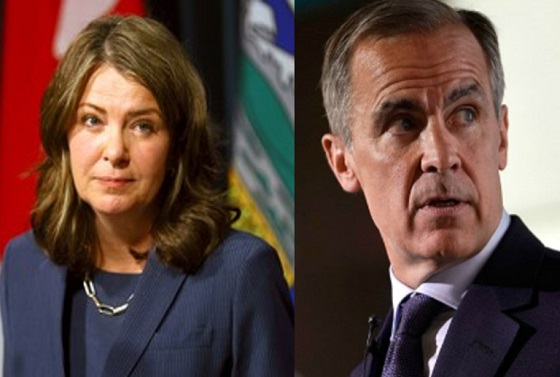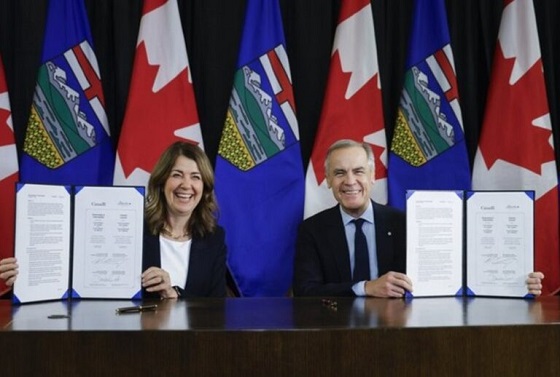Alberta
Retired Oil Field Worker sparks national conversation with his pitch for a new route to move Alberta Oil

The following Opinion piece comes from local writer / editorialist (and former oil field worker) Garfield Marks.
We have not been able to run our bitumen through a pipeline to a refinery in New Brunswick. There has been resistance in parts of Ontario and in Quebec. What if we came up with another plan. Would we consider it? There will be road blocks, but not insurmountable, would we consider it?
Yes how about Thunder Bay?
Thunder Bay, Ontario, the largest Canadian port of the St. Lawrence Seaway located on the west end of Lake Superior, 1850 kms. from Hardisty, Alberta. A forgotten jewel.
So what, you may ask.
They used to ship grain from Thunder Bay in huge tankers to ports all over the world. Why not oil?
The Saint Lawrence Seaway ships fuel, gasoline and diesel tankers, to this day.
We could run oil tankers to the Irving refinery in New Brunswick, bypassing the controversial pipeline running through eastern Ontario and Quebec.
The pipeline, if that was the transport model chosen, would only need to run through parts of Alberta, Saskatchewan, Manitoba and Ontario. Like, previously stated the pipeline would only be 1850 kms. long.
The other great thing about Thunder Bay is the abundance of rail lines. Transportation for such things as grain and forestry products from western Canada. If you can’t run pipeline from Hardisty, through to Thunder Bay, use the railroad.
Why Hardisty, you may ask.
Hardisty, according to Wikipedia, is mainly known as a pivotal petroleum industry hub where petroleum products such as Western Canada Select blended crude oil and Hardisty heavy oil are produced, stored and traded.
The Town of Hardisty owes its very existence to the Canadian Pacific Railway. About 1904 the surveyors began to survey the railroad from the east and decided to locate a divisional point at Hardisty because of the good water supply from the river.
Hardisty, Alberta has the railroad and has the product, the storage capacity, and the former Alberta government planned on investing $3.7 billion in rail cars for hauling oil while Thunder Bay has the railroad and an under utilised port at the head of the St. Lawrence Seaway.
Economics are there along with opportunity, employment would be created and the east coast could end its’ dependency on imported oil.
Do we have the vision or willingness to consider another option. I am just asking for all avenues to be considered.
In my interviews in Ontario there is a willingness to discuss this idea.
The St. Lawrence Seaway Management Corporation is still reviewing the idea of shipping crude oil from western Canada through its system, and it’s a long way from happening, according to Bruce Hodgson, the Seaway’s director of market development.
“Obviously, there needs to be an ongoing commitment on the part of a producer, and so that’s going to be required for any project of this nature,” he said.
We could consider it, could we not?
CBC NEWS did a story about this idea on March 7 2019;
A retired oil field worker in Alberta has “floated” a novel solution to Alberta’s oil transportation woes: pipe the bitumen to Thunder Bay, Ont., then ship it up the St. Lawrence Seaway to the Irving oil refinery in New Brunswick.
Marks’ proposal might be more than a pipe dream, according to the director of the Queen’s Institute for Energy and Environmental Policy.
‘I don’t think that it’s a totally nuts idea’
“I don’t think that it’s a totally nuts idea,” Warren Mabee said. “I think that there’s some flaws to it … but this is an idea that could work in certain circumstances and at certain times of year. … It’s not the craziest thing I’ve ever heard.”
The chief executive officer of the Port of Thunder Bay said shipping oil from the port “could easily be done.”
“We ship refined gasoline and diesel up from Sarnia. We’ve done that for many many years,” Tim Heney told CBC. “So it’s not something that’s that far-fetched.”
There are, however, plenty of potential drawbacks to shipping crude through the Seaway, Mabee explained, not least of which is the fact that it isn’t open year-round.
The need to store oil or redirect it during the winter months could be costly, he said.
Potential roadblocks
Another potential pitfall is capacity, he added; there may not be enough of the right-sized tankers available to carry the oil through the Seaway.
Finally, he said, the journey by sea from Lake Superior to the Irving refinery in New Brunswick is a long one, so it might make more sense to transport the product to a closer facility such as the one in Sarnia, Ont.
The St. Lawrence Seaway Management Corporation is still reviewing the idea of shipping crude oil from western Canada through its system, and it’s a long way from happening, according to Bruce Hodgson, the Seaway’s director of market development.
“Obviously, there needs to be an ongoing commitment on the part of a producer, and so that’s going to be required for any project of this nature,” he said.
So far, no producer has come forward seeking to ship crude through Thunder Bay, he said.
Asked about the possible environmental risks of shipping oil on Lake Superior, both Hodgson and Heney said shipping by tanker is relatively safe; Hodgson noted that any tankers carrying the product would have to be double-hulled, and crews are heavily vetted.
Time to rethink pipelines?
There hasn’t been a spill in the Seaway system for more than 20 years he said.
Nonetheless, Mabee said, the potential for an oil spill on the Great Lakes could be a huge issue.
“The St. Lawrence and the Great Lakes have a lot of people living in close proximity, a lot of people who rely on it for drinking water,” he said. “There’s a delicate ecosystem there. I think a lot of people would push back against this proposal simply from that perspective.”
In fact, one of the reasons Mabee appreciates Marks’ proposal, he said, is because it invites people to weigh the pros and cons of different methods of transporting oil.
“If we’re not going to build pipelines, but we’re going to continue to use oil, it means that people are going to be looking at some of these alternative transport options,” he said.
“And if we don’t want oil on those alternative transport options, we need to give the pipelines another thought.
Time to consider all options, I dare say.
Garfield Marks
Alberta
The Canadian Energy Centre’s biggest stories of 2025

From the Canadian Energy Centre
Canada’s energy landscape changed significantly in 2025, with mounting U.S. economic pressures reinforcing the central role oil and gas can play in safeguarding the country’s independence.
Here are the Canadian Energy Centre’s top five most-viewed stories of the year.
5. Alberta’s massive oil and gas reserves keep growing – here’s why

The Northern Lights, aurora borealis, make an appearance over pumpjacks near Cremona, Alta., Thursday, Oct. 10, 2024. CP Images photo
Analysis commissioned this spring by the Alberta Energy Regulator increased the province’s natural gas reserves by more than 400 per cent, bumping Canada into the global top 10.
Even with record production, Alberta’s oil reserves – already fourth in the world – also increased by seven billion barrels.
According to McDaniel & Associates, which conducted the report, these reserves are likely to become increasingly important as global demand continues to rise and there is limited production growth from other sources, including the United States.
4. Canada’s pipeline builders ready to get to work
Canada could be on the cusp of a “golden age” for building major energy projects, said Kevin O’Donnell, executive director of the Mississauga, Ont.-based Pipe Line Contractors Association of Canada.
That eagerness is shared by the Edmonton-based Progressive Contractors Association of Canada (PCA), which launched a “Let’s Get Building” advocacy campaign urging all Canadian politicians to focus on getting major projects built.
“The sooner these nation-building projects get underway, the sooner Canadians reap the rewards through new trading partnerships, good jobs and a more stable economy,” said PCA chief executive Paul de Jong.
3. New Canadian oil and gas pipelines a $38 billion missed opportunity, says Montreal Economic Institute

Steel pipe in storage for the Trans Mountain Pipeline expansion in 2022. Photo courtesy Trans Mountain Corporation
In March, a report by the Montreal Economic Institute (MEI) underscored the economic opportunity of Canada building new pipeline export capacity.
MEI found that if the proposed Energy East and Gazoduq/GNL Quebec projects had been built, Canada would have been able to export $38 billion worth of oil and gas to non-U.S. destinations in 2024.
“We would be able to have more prosperity for Canada, more revenue for governments because they collect royalties that go to government programs,” said MEI senior policy analyst Gabriel Giguère.
“I believe everybody’s winning with these kinds of infrastructure projects.”
2. Keyera ‘Canadianizes’ natural gas liquids with $5.15 billion acquisition

Keyera Corp.’s natural gas liquids facilities in Fort Saskatchewan, Alta. Photo courtesy Keyera Corp.
In June, Keyera Corp. announced a $5.15 billion deal to acquire the majority of Plains American Pipelines LLP’s Canadian natural gas liquids (NGL) business, creating a cross-Canada NGL corridor that includes a storage hub in Sarnia, Ontario.
The acquisition will connect NGLs from the growing Montney and Duvernay plays in Alberta and B.C. to markets in central Canada and the eastern U.S. seaboard.
“Having a Canadian source for natural gas would be our preference,” said Sarnia mayor Mike Bradley.
“We see Keyera’s acquisition as strengthening our region as an energy hub.”
1. Explained: Why Canadian oil is so important to the United States

Enbridge’s Cheecham Terminal near Fort McMurray, Alberta is a key oil storage hub that moves light and heavy crude along the Enbridge network. Photo courtesy Enbridge
The United States has become the world’s largest oil producer, but its reliance on oil imports from Canada has never been higher.
Many refineries in the United States are specifically designed to process heavy oil, primarily in the U.S. Midwest and U.S. Gulf Coast.
According to the Alberta Petroleum Marketing Commission, the top five U.S. refineries running the most Alberta crude are:
- Marathon Petroleum, Robinson, Illinois (100% Alberta crude)
- Exxon Mobil, Joliet, Illinois (96% Alberta crude)
- CHS Inc., Laurel, Montana (95% Alberta crude)
- Phillips 66, Billings, Montana (92% Alberta crude)
- Citgo, Lemont, Illinois (78% Alberta crude)
Alberta
Alberta Next Panel calls for less Ottawa—and it could pay off

From the Fraser Institute
By Tegan Hill
Last Friday, less than a week before Christmas, the Smith government quietly released the final report from its Alberta Next Panel, which assessed Alberta’s role in Canada. Among other things, the panel recommends that the federal government transfer some of its tax revenue to provincial governments so they can assume more control over the delivery of provincial services. Based on Canada’s experience in the 1990s, this plan could deliver real benefits for Albertans and all Canadians.
Federations such as Canada typically work best when governments stick to their constitutional lanes. Indeed, one of the benefits of being a federalist country is that different levels of government assume responsibility for programs they’re best suited to deliver. For example, it’s logical that the federal government handle national defence, while provincial governments are typically best positioned to understand and address the unique health-care and education needs of their citizens.
But there’s currently a mismatch between the share of taxes the provinces collect and the cost of delivering provincial responsibilities (e.g. health care, education, childcare, and social services). As such, Ottawa uses transfers—including the Canada Health Transfer (CHT)—to financially support the provinces in their areas of responsibility. But these funds come with conditions.
Consider health care. To receive CHT payments from Ottawa, provinces must abide by the Canada Health Act, which effectively prevents the provinces from experimenting with new ways of delivering and financing health care—including policies that are successful in other universal health-care countries. Given Canada’s health-care system is one of the developed world’s most expensive universal systems, yet Canadians face some of the longest wait times for physicians and worst access to medical technology (e.g. MRIs) and hospital beds, these restrictions limit badly needed innovation and hurt patients.
To give the provinces more flexibility, the Alberta Next Panel suggests the federal government shift tax points (and transfer GST) to the provinces to better align provincial revenues with provincial responsibilities while eliminating “strings” attached to such federal transfers. In other words, Ottawa would transfer a portion of its tax revenues from the federal income tax and federal sales tax to the provincial government so they have funds to experiment with what works best for their citizens, without conditions on how that money can be used.
According to the Alberta Next Panel poll, at least in Alberta, a majority of citizens support this type of provincial autonomy in delivering provincial programs—and again, it’s paid off before.
In the 1990s, amid a fiscal crisis (greater in scale, but not dissimilar to the one Ottawa faces today), the federal government reduced welfare and social assistance transfers to the provinces while simultaneously removing most of the “strings” attached to these dollars. These reforms allowed the provinces to introduce work incentives, for example, which would have previously triggered a reduction in federal transfers. The change to federal transfers sparked a wave of reforms as the provinces experimented with new ways to improve their welfare programs, and ultimately led to significant innovation that reduced welfare dependency from a high of 3.1 million in 1994 to a low of 1.6 million in 2008, while also reducing government spending on social assistance.
The Smith government’s Alberta Next Panel wants the federal government to transfer some of its tax revenues to the provinces and reduce restrictions on provincial program delivery. As Canada’s experience in the 1990s shows, this could spur real innovation that ultimately improves services for Albertans and all Canadians.
-

 Business3 hours ago
Business3 hours agoICYMI: Largest fraud in US history? Independent Journalist visits numerous daycare centres with no children, revealing massive scam
-

 Energy2 days ago
Energy2 days agoThe Top News Stories That Shaped Canadian Energy in 2025 and Will Continue to Shape Canadian Energy in 2026
-

 Daily Caller1 day ago
Daily Caller1 day agoUS Halts Construction of Five Offshore Wind Projects Due To National Security
-

 Daily Caller1 day ago
Daily Caller1 day agoWhile Western Nations Cling to Energy Transition, Pragmatic Nations Produce Energy and Wealth
-

 Alberta1 day ago
Alberta1 day agoAlberta Next Panel calls for less Ottawa—and it could pay off
-

 Fraser Institute2 days ago
Fraser Institute2 days agoCarney government sowing seeds for corruption in Ottawa
-

 Bruce Dowbiggin1 day ago
Bruce Dowbiggin1 day agoBe Careful What You Wish For In 2026: Mark Carney With A Majority
-

 Energy2 days ago
Energy2 days agoWhy Japan wants Western Canadian LNG








